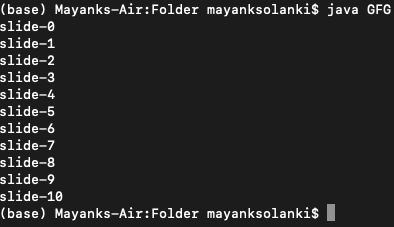在Java,如果一个线程不想在特定的时间内执行任何操作,那么我们应该使用 sleep() 方法,它会导致当前正在执行的线程停止指定的毫秒数。
句法 :
public static native void sleep( long ms) throws InterruptedException ;
// The above method put the thread in sleep for a specified number of millisecondpublic static void sleep(long ms , int ns) throws InterruptedException
// The above method also put the thread in sleep for a specified number of milliseconds
// plus specified number of nanoseconds方法一: sleep()方法
Java的每个 sleep() 方法都会抛出一个 InterruptedException ,这是一个已检查的异常,因此每当我们强制使用 sleep 方法时,我们应该通过 try-catch 或 throws 关键字来处理它,否则我们将得到编译时错误。
实现:在这里,我们在“ println ”语句之后让主线程休眠 5 秒。所以每张幻灯片需要 5 秒的时间来打印。
例子
Java
// Java Program to illustrate sleep method
// Importing all input output classes
import java.io.*;
// Importing all utility classes from
// java.util package
import java.util.*;
// Main class
class GFG {
// Main driver method
public static void main(String[] args)
throws InterruptedException
{
// Iterating using simple for loops
for (int i = 0; i <= 10; i++) {
// Printing the current thread slide
System.out.println("slide-" + i);
// Putting the main thread to sleep for 5 second
Thread.sleep(5000);
}
// Here after every 5 seconds a slide will be
// printed
}
}Java
// Java Program to illustrate yield() method
// Importing input output classes
import java.io.*;
// Importing all utility classes
import java.util.*;
// Class 1
// Helper class extending Thread class
// Creating a thread in our myThread class
// by extending the Thread class
class myThread extends Thread {
// Method in helper class
// Declaring run method
public void run()
{
// Displaying the message
System.out.println("Child Thread");
// Calling yield() method
Thread.yield();
}
}
// Class 2
// Main class
class GFG {
// Main driver method
public static void main(String[] args)
throws InterruptedException
{
// Creating a thread object in the main() method
// of our helper class above
myThread t = new myThread();
// Starting the above thread created
// using the start() method
t.start();
// Iterating using for loop
// over custom taken size equals 5
for (int i = 0; i < 5; i++) {
// Display message
System.out.println("Main Thread");
}
}
}输出:

Note: Here slide-1 will be printed after slide-0 after 5000 nanoseconds so do apply for the rest of all the slides. Hence this output will be displayed taking a certain time in execution in the runtime state.
方法二: yield()方法
它会导致暂停当前正在执行的线程,以便有机会等待相同优先级的线程。如果没有等待线程或所有等待线程都具有低优先级,则同一线程可以继续执行。如果多个线程以相同的优先级等待,那么哪个等待线程将有机会我们不能说这取决于线程调度程序。线程何时再次获得机会也取决于线程调度程序。
句法:
public static native void yield( );执行:
例子
Java
// Java Program to illustrate yield() method
// Importing input output classes
import java.io.*;
// Importing all utility classes
import java.util.*;
// Class 1
// Helper class extending Thread class
// Creating a thread in our myThread class
// by extending the Thread class
class myThread extends Thread {
// Method in helper class
// Declaring run method
public void run()
{
// Displaying the message
System.out.println("Child Thread");
// Calling yield() method
Thread.yield();
}
}
// Class 2
// Main class
class GFG {
// Main driver method
public static void main(String[] args)
throws InterruptedException
{
// Creating a thread object in the main() method
// of our helper class above
myThread t = new myThread();
// Starting the above thread created
// using the start() method
t.start();
// Iterating using for loop
// over custom taken size equals 5
for (int i = 0; i < 5; i++) {
// Display message
System.out.println("Main Thread");
}
}
}

输出说明:
在上面的程序中,如果我们注释Thread.yield() 行,两个线程将同时执行,我们不能指望哪个线程会先完成。如果我们不评论Thread.yield()方法,那么因为主线程将获得更多的机会,并且首先完成主线程的机会很高。
所以最后我们完成了这两种方法,让我们最后总结它们之间的差异。
| Property | Yield Method | Sleep Method |
|---|---|---|
| Purpose | If a thread wants to pause its execution to give chance for the remaining thread of the same priority then we should go for the yield method. | If a thread doesn’t want to perform any operation for a particular amount of time then we should go for the sleep method |
| Over-loading | This method is not overloaded | The sleep method is overloaded. |
| Exception | This method doesn’t throw an exception | This method throws Interrupted Exception |
| Native | This method is native | Amongst the two overloaded methods, only sleep(long ms) is overloaded while the other is not. |
| Give up monitors | This method gives up the monitors. | This method doesn’t cause the currently executing thread to give up monitors. |